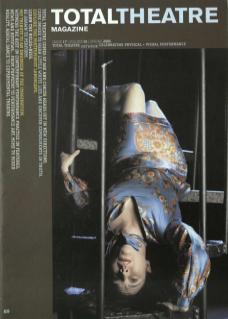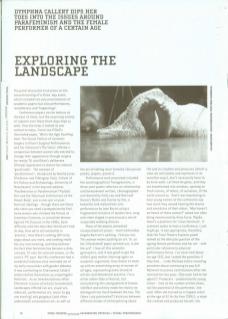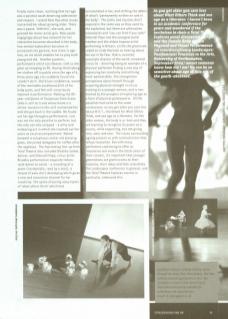The panel discussion took place on the second morning of a three-day event, which included not only presentations of academic papers but also performances, installations and 'happenings'.
Conference papers can be tedious at the best of times, but the surprising variety of subjects over those three days kept us alert. How the body is looked at was central to many. Carrie Lee O'Dell's illustrated paper, 'Who's the Ugly Duckling here: The Sexual Politics of Cosmetic Surgery in Orlan's Surgical Performances and Fox Television's The Swan' offered a comparison between women who elected to change their appearance through surgery for reality TV, and Orlan's deliberate (filmed) operations to distort her natural good looks. The concept of ‘parafeminism', introduced by Amelia Jones (Professor and Pilkington Chair, School of Art History and Archaeology, University of Manchester) in her keynote address ‘Postfeminism or Parafeminism? Piplotti Rist and the Televisual Architecture of the Dream Body' put a new spin on post-feminist ideology – though there are those who claim you need a post-patriarchy first. Some women who climbed the fences at Greenham Common, or joined the Women Against Pit Closures in the 1980s, have difficulty with the idea that feminism's had its day, that we're all constantly in process, that there's nothing left to be angry about any more, and nothing really has any real meaning, and they bemoan the fact that feminism has become a dirty concept, fit only for satirical swipes, or the cynic's 'PC' pyre. But this conference had a wonderful liveliness that reminded me of my early encounters with gender debates. It was comforting to find several (older) women define themselves as unapologetic feminists. As an interdisciplinary affair (feminism crosses all artistic boundaries), Landscapes offered live art, visual art, video art, performance art, music (a gig one evening) and gorgeous (and often underrated) conversation art, as well as the art of talking more formally (discussion panels, papers, posters).
Performance work presented included the autobiographical Transgressions, a three-part poetic refection on relationship and bereavement written, choreographed and danced by Holly Lou, and Red Leaf Dance's Myths and Stories by Her, a beautiful and melancholic solo performance by Jane Bacon using a fragmented narrative of spoken text, song and video staged in and around a sea of suspended wedding dresses.
Many of the papers presented incorporated art praxis – most memorably Angela Bartram's spitting. I kid you not. This woman makes spitting an art. Or, as her (illustrated) paper pointed out, is she the art? I love all this semantic gymnastics, and it was good to get the old(er) grey matter churning again on academic arguments. Even better to meet up with an astonishing array of women of all ages, representing every strand of artistic and theoretical practice. I'm a writer rather than a theorist, but encountering this smorgasbord of female intellect and artistry made me realise we distinguish too much between the two. The (dare I say patriarchal?) divisions between different modes of philosophising about life and its troubles and pleasures (which is what art articulates and expresses in its manifest ways), don't necessarily have to be brick walls. Let them be glass, and they are transformed into windows, opening on fresh visions of others, of ourselves, of the world around us. And it was heartening to hear young women at the conference say how much they valued hearing the stories and anecdotes of their elders. ‘Why haven't we heard of these women?' Asked one after being mesmerised by Anna Furse. Maybe there's a platform for 'silver feminism'. If someone wants to host a conference, I just might go. It was appropriate, therefore, that the Total Theatre Explores panel looked at the delicate question of the ageing female performer and her art – with particular reference to physical performance forms. I've never lied about my age (52), but I asked the panellists if they had... Linda Marlowe told a revealing anecdote about continuing to pay full National Insurance contributions after she received her bus pass. (She even lied to her agent!) 'Producers – predominantly young males – look at the number written down, not the potential of the performer,' she said. When she trained as a trapeze artist at the age of 62 for No Fear (2001), a show she created and produced herself, she finally came clean, realising that her age was a positive asset deserving admiration and respect. I asked Nola Rae what issues concerned her about growing older. There was a pause. 'Arthritis,' she said, and grinned her mime-artist grin. Nola spoke engagingly about how research for her characters becomes absorbed in the body, how mental exploration becomes reprocessed into gesture, how mime is ageless, an art which enables her to play both young and old. Another panellist, performance artist Lois Weaver, told us she gave up stripping at 50. Having liked taking her clothes off in public since the age of six, three years ago Lois suddenly found she couldn't do it. She'd lost confidence, aware of the inevitable southward drift of her body parts, and felt self-consciously exposed in performance. Meeting the 80 year-old Queen of Striptease Dixie Evans (who is still at it and whose home is a shrine-museum to this art) revitalised her and she got back in the saddle. We found out her age through a performance. Lois was not the only panellist to perform, but the only one who stripped – a witty and endearing act in which she counted out her years as vocal accompaniment. Naked beneath a voluptuous winter red dressing gown, she joined delegates for coffee after the applause. The fascinating line-up from Total Theatre also included Bisakha Sarker, dancer, and Deborah Pope, circus artist. Bisakha performed an exquisite Indian style dance to words – a recording of a poem (incidentally, read by a man), a strand of work she's developing which gives a new and innovative channel for her creativity. She spoke of paring away layers of 'what others think' which had accumulated in her, and shifting the debris of what's 'permanently written on and in the body'. The joints and muscles don't respond in the same way as they used to, she explained, but there are alternative movements and ‘you can find if you seek’. Deborah Pope was the youngest panel member and the oldest trapeze artist performing in Britain, a title she graciously ceded to Linda Marlowe on hearing about her act in No Fear. Deb is currently associate director of the world-renowned Circus Oz – directing being an example of a physical performer finding a new way of expressing her creativity and utilising hard-earned skills. She changed her perceptions about herself through acquiring physical strength in circus training as a younger woman, and is now excited by the prospect of exploring age as a form of physical grotesquerie. All the panellists had come to the same conclusions: as you get older you care less about W.O.T., shorthand for What Others Think, and see age as a liberator. For the older woman, the body is ur-text and they are learning to recognise its power as a source, while respecting, but not giving into, wear and tear. The issues surrounding ageing present us with contradictions that refuse resolution. But with many performers continuing to offer us innovative work in the latter years of their careers, it's important that younger generations are given access to their histories, their ideas and their anecdotes. The Landscapes conference in general, and the Total Theatre Explores session in particular, embraced this.
Dymphna Callery is writing a follow-up to Through the Body (Nick Her Books), this time tackling somatic approaches to text. She continues to teach at the University of Wolverhampton and is available for workshops and consultancies. Email: d.callery@wlv.ac.uk


